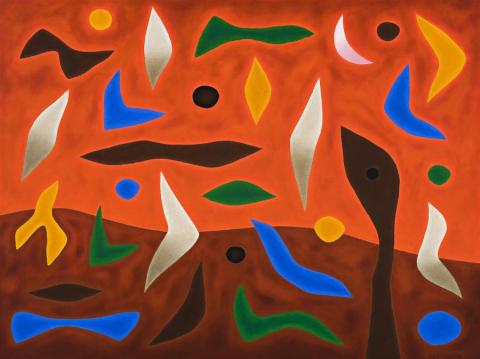LANDSCAPE OF DESIRE, 1986
JOHN COBURN
oil on canvas
137.0 x 183.0 cm
signed and dated lower right: Coburn '86
dated and inscribed verso: JOHN COBURN / LANDSCAPE OF DESIRE (OIL) / 1986
Solander Gallery, Canberra
Private collection, Sydney, acquired from the above c1994
Amadio, N., John Coburn: Paintings, Craftsman House, Sydney, 1988, p. 204
Renowned for his abstract portrayals of the Australian landscape and the seasons, using geometric forms contrasted against flat planes, John Coburn is one of Australia's most recognisable artists. In Landscape of Desire, 1986, Coburn utilises colour and his distinctive motifs to depict a vibrant and harmonious landscape. Fusing balance and asymmetry to create spatial coherence, the circular and angular forms appear to move up and across the canvas, suggesting life and vitality. In this painting, Coburn allows the viewer to consider their own landscape of desire through the ambiguous forms, unrestricted by his distinctive iconography. '... I like all my shapes to be ambiguous so that people can read into them what they like. It happens with all art, doesn't it? I mean, even with realism people can read other things into it. There is often symbolism behind what is visually depicted. I don't mind what interpretation people place on it even if they misconstrue my original intentions. In fact I quite like that: I think that's all part of my work.'1
Coburn's early childhood was spent in the north of Queensland. The lush rainforests and gardens of his youth provided a strong connection to the Australian environment, resonating throughout his career. Coburn's depictions of the 'land' are allegorical and sensory visions that evoke strong emotions from his audience and are therefore somewhat similar to the deep connection embodied between Aboriginal artists and their illustrations of the land. On some level Coburn, like Aboriginal artists, always connects his work to his country both as a physical place and as a spiritual landscape.2
Coburn was a true master of colour, contrasting light against dark, primary against secondary and warm against cool. Employing a theory of colour, his works are saturated with emotion and the celebration of life as evident in Landscape of Desire. The strong red background indicates energy and passion, while the contrasting colours of blue and green allude to another of Coburn's favoured themes; renewal. Drawing upon masters such as Henri Matisse and the American Expressionist painter Mark Rothko, Coburn explored the nature of colour and its effect on human emotion. Like Rothko, Coburn believed his works needed to be experienced on a higher level than a mere visual encounter. As Lou Klepac discusses 'Colour is not inert, it is vibration. In special combinations it creates something like a chemical reaction: the result becomes dynamic and electrifying.'3
1. John Coburn quoted in Klepac, L., John Coburn: The Spirit of Colour, The Beagle Press, Sydney, 2003, p. 104
2. Amadio, N., John Coburn: Paintings, Craftsman House, Sydney, 1988, p. 7
3. Klepac, op cit., p. 15
CASSI YOUNG
